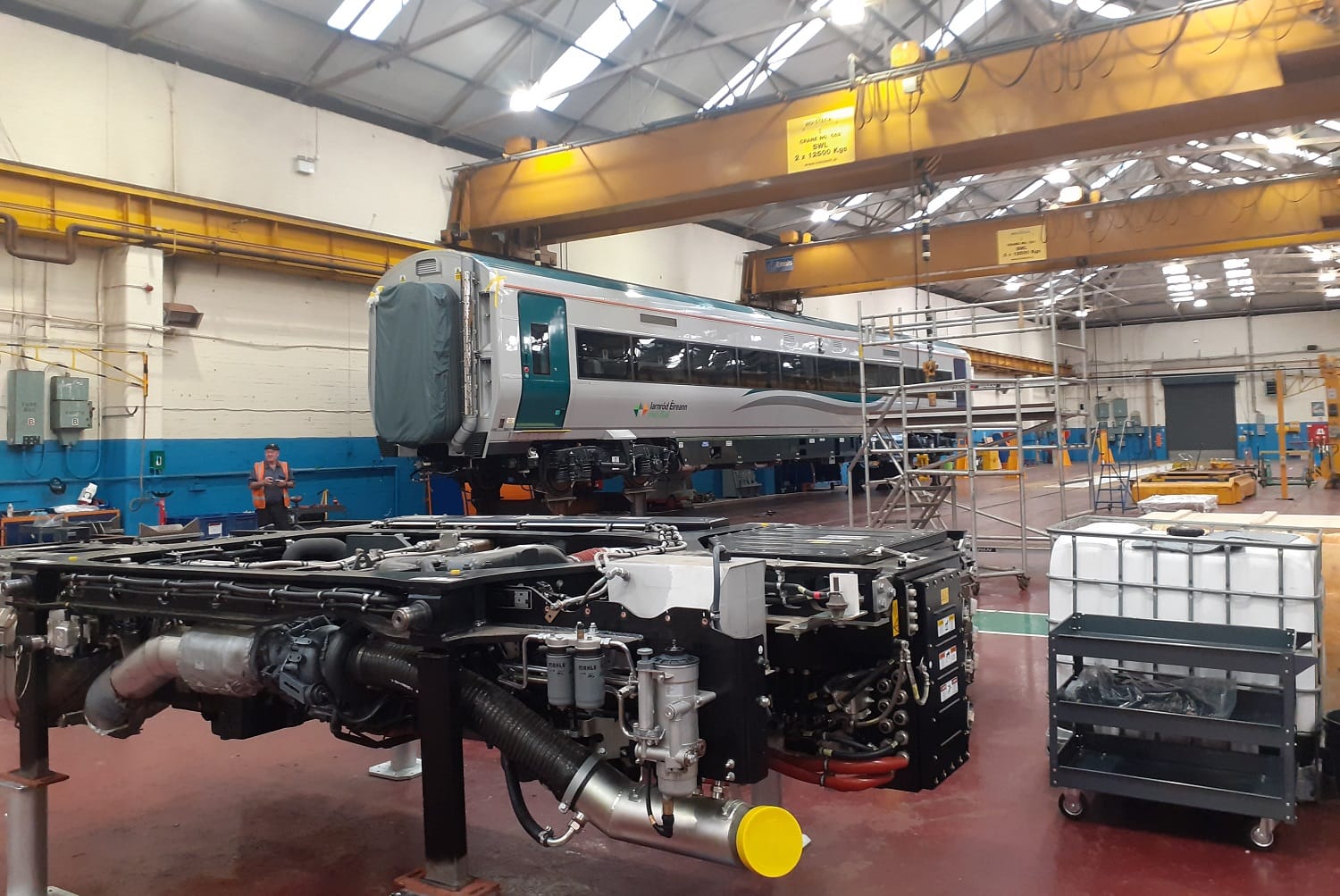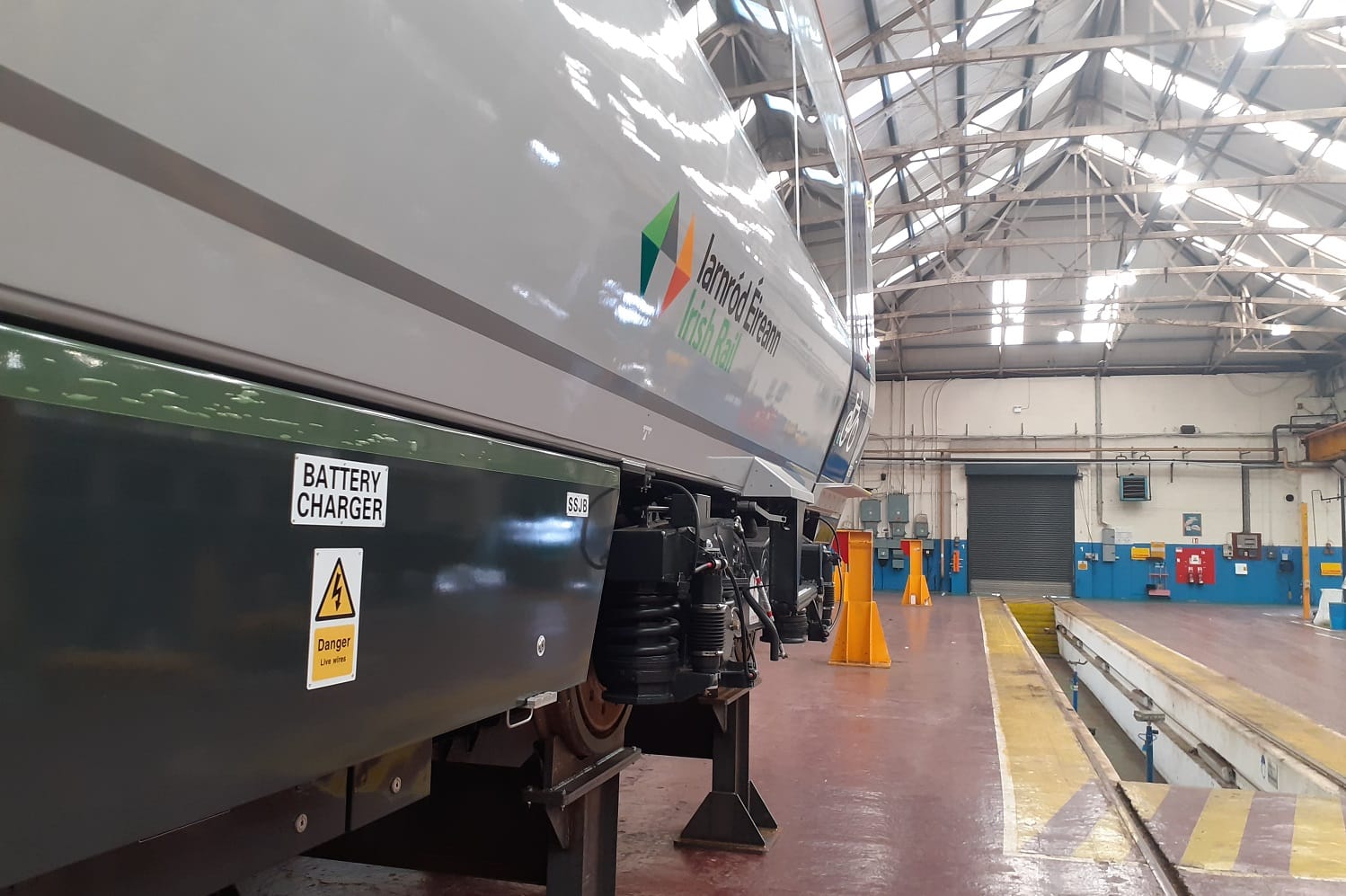What’s the best way to tell area residents about plans for a new asylum shelter nearby?
The government should tell communities directly about plans for new asylum shelters, some activists and politicians say.
At the Inchicore Railway Works, Stephen Campbell and his team have been working for more than four years on ways to green Irish Rail’s fleet.

Stephen Campbell pushes open the door to a workshop in the Inchicore Railway Works.
Inside, Campbell and his team have been working for more than four years on ways to green Irish Rail’s fleet, adapting it towards hybrid diesel and electric battery.
Campbell walks towards the dominating feature of the wide room: a grey and green Irish Rail train carriage, two metres above the ground on stilts.
In the carriage’s engine is a black-box power pack. It’s the newest update to the diesel engine, he says.
Campbell says the company has a policy incentive, if not a financial one, to begin to transition to greener energy.
“The government is very much seeking for public transport to reduce our carbon footprint as much as possible, and they’re looking for investment opportunities,” he says.
Four years ago, as they started to work on making their existing engines greener, they found out it might be possible to move to a newer kind of engine, that could be adaptable to battery power, and turn the diesel trains into diesel-electric hybrids, he says.
The aim, Campbell says, is to cut the amount of fuel that the trains use by 30 percent and emit 30 percent less carbon dioxide, nitrogen oxide and particulate matter.
Mark Gleeson, secretary of Rail Users Ireland, which represents train customers, says that reducing the fuel consumption by that much would be huge.
The diesel trains hold about 1,000 litres of diesel, which lasts for a day and a half of train driving, he says.
“That’s a massive cash saving,” says Gleeson, and trains won’t have to refuel as often.
Workmen in orange fluorescent jackets walk about the workhouse, between the motionless train carriages and yellow beams that run from floor to ceiling.
Campbell approaches a freestanding engine in the centre of the workshop. They’re using this one, called a stage 5 engine, for tests, he says.
The first step, which began in 2017, was to adjust how the existing trains’ engines, called stage 3a engines, change gears. At the base of the engine is a silver cog-like attachment, a red wire snaking from it back into the engine.

This is the new transmission or gearbox, says Campbell.
Normally, Irish Rail trains have just two gears. The engine gulps in fuel to jump between them when stopping and starting.
The new transmission has six gears. The train can speed up and slow down more smoothly – and use less fuel, says Campbell.
It’s responsible for reducing a test train’s emissions by 18 percent, he says. “So it’s really, really good bang for your buck.”
Drivers and passengers can hear the difference, too, he says. The old gearboxes scream as they take off, he says. “These ones here, they’re very quiet.”
Irish Rail have a tender out at the moment to install new transmissions on their existing stage 3a engines, he says.
The new stage 5 engines, like the one next to Campbell in the workshop, have this transmission too. Irish Rail has ordered 41 vehicles with stage 5 engines, says Campbell. They have started to arrive already, a few dotted around the Inchicore Works.
Stage 5 engines are Rolls Royce manufactured, and unlike the stage 3as, they can be connected to an electric battery pack, which can be charged by the train’s brakes and used to power the train.
Campbell ducks his head under the grey metal panels that line the underside of the train carriage on stilts.
A shiny aluminium tank is visible between the panels. Gas from exhaust is directed through this tank for aftertreatment – which takes out pollutants, he says.
The stage 5 engines also come decked out with a smaller power pack, with just a single purpose.
Train stations are thicker with noise and air pollution than outside, because the trains are usually idling while awaiting take off.
But the only reason they idle is so there is heat and light for waiting passengers, he says. “We don’t really need to run the engine for any other reason.”
These small power packs would mean they wouldn’t have to idle, but could still keep the lights on, he says.
Campbell says trains idle for different lengths of time. “If, for example, there’s a morning run out of Galway at five o’clock in the morning, that station manager, it would be his responsibility.”
Given the variation, it’s hard to put a figure on emissions saved thanks to the power packs, he says.
Still, Gleeson, of Rail Users Ireland, says the use of these battery packs is good news for people who live next to stations. “Connolly in particular is full of smoke, the engines there belching out smoke.”
Outside Heuston Station, a monitoring station on St. John’s Road Westbroke EU limits on average air pollution levels in 2019, hitting 43 μg/m3. The breach forced the four Dublin councils to draw up a joint air-quality plan.
The plan called for further research on the impact of rail emissions at large railway hubs in urban areas.
Finally, Campbell says the team are also now working on hybrid drives for their new trains, converting energy created when the train brakes into battery energy, and using the battery power to drive in and out of the stations. “To reduce the smoke in the station.”
Batteries for these engines are currently in production in Germany, says Campbell. “They’re due to arrive hopefully August time, and we will fit them in in September.”
Irish Rail plans to adapt nine engines to begin with: three in 2023, and six in 2024.
“If it’s a resounding success, maybe we can make a business case for the rest of the fleet,” he says. The aim is for the batteries to reduce emissions and fuel consumption by 10 percent.
If there are too many issues, or it doesn’t reduce emissions as much as hoped, it may not be worth it, he says. “If it’s only okay or it’s only good, then you know, we might just stick with the gearbox solution.”
The technology hasn’t been tested with their engines before, says Campbell. “That’s why we’re doing it in stages, so that we’re not just jumping two feet first into it.”
Engines may break down, turn off, stall, or leak oil, he says. “Our previous engines, for example, turbo could break, reduce the available power, train has to go back and has to be fixed, go back out into service again, it’s just expensive and time consuming.”

There are promising works in London, where Chiltern Railways has been running a hybrid passenger train since last year, he says.
“They have a mile of electric into London,” he says, and from what he’s heard, it’s working well technically.
It’s easier for Irish Rail to switch into hybrid, rather than go fully into electric, because all it takes is adapting the trains that already exist, says Campbell.
The engines typically last around 30 years, he says. “Making it hybrid will extend its green life.”
But it’s expensive, he says. He estimates the cost per hybrid train at €800,000 to €1 million, he says.
“We’re trying to find the most viable pathway, the best solution, whilst also considering economic factors, how much it’s going to cost,” he says.
Transitioning the whole fleet to hybrid, at €1 million a carriage, upgrading the entire fleet could cost at least €250 million, he says. “That’s eye watering.”
Gleeson, of Rail Users Ireland, says he’s not sure if the budget has been set for hybrid rail, beyond the nine trains planned for this year and next.
At some point, Irish Rail’s engines will need to be replaced, he says. “It’s not a cost, something they had to spend already.”
Irish Rail have committed around €5 million, and the government €1.12 million, to fund the project trials, says Jane Cregan, a public relations spokesperson for Irish Rail.
The government’s Climate Action Fund has also committed up to €15 million for rolling the project out to the wider train fleet, she says.
Hybrid is a win-win, says Gleeson. “There’s no compromise on performance, not like cars with efficiency.”
Going fully electric is still a while off, says Gleeson. To replace these engines, which would be at the end of their life anyway, with hybrid, while the technology is there, is a good move.
“It’s really exciting. It’s kind of cool, once we prove the concept that we can adjust it and refine it and change it around, you know,” says Campbell.
Get our latest headlines in one of them, and recommendations for things to do in Dublin in the other.